+ Open data
Open data
- Basic information
Basic information
| Entry | Database: PDB / ID: 5uj8 | ||||||
|---|---|---|---|---|---|---|---|
| Title | Human Origin Recognition Complex subunits 2 and 3 | ||||||
 Components Components |
| ||||||
 Keywords Keywords | HYDROLASE / ORC / Replication / ATPase | ||||||
| Function / homology |  Function and homology information Function and homology informationCDC6 association with the ORC:origin complex / origin recognition complex / E2F-enabled inhibition of pre-replication complex formation / nuclear origin of replication recognition complex / nuclear pre-replicative complex / inner kinetochore / DNA replication preinitiation complex / neural precursor cell proliferation / regulation of DNA replication / DNA replication origin binding ...CDC6 association with the ORC:origin complex / origin recognition complex / E2F-enabled inhibition of pre-replication complex formation / nuclear origin of replication recognition complex / nuclear pre-replicative complex / inner kinetochore / DNA replication preinitiation complex / neural precursor cell proliferation / regulation of DNA replication / DNA replication origin binding / DNA replication initiation / Activation of the pre-replicative complex / Activation of ATR in response to replication stress / glial cell proliferation / heterochromatin / Assembly of the ORC complex at the origin of replication / Assembly of the pre-replicative complex / Orc1 removal from chromatin / DNA replication / chromosome, telomeric region / nuclear body / centrosome / chromatin / negative regulation of transcription by RNA polymerase II / nucleoplasm / nucleus / membrane Similarity search - Function | ||||||
| Biological species |  Homo sapiens (human) Homo sapiens (human) | ||||||
| Method |  X-RAY DIFFRACTION / X-RAY DIFFRACTION /  SYNCHROTRON / SYNCHROTRON /  MOLECULAR REPLACEMENT / Resolution: 6 Å MOLECULAR REPLACEMENT / Resolution: 6 Å | ||||||
 Authors Authors | Tocilj, A. / On, K.F. / Elkayam, E. / Joshua-Tor, L. | ||||||
 Citation Citation |  Journal: Elife / Year: 2017 Journal: Elife / Year: 2017Title: Structure of the active form of human origin recognition complex and its ATPase motor module. Authors: Ante Tocilj / Kin Fan On / Zuanning Yuan / Jingchuan Sun / Elad Elkayam / Huilin Li / Bruce Stillman / Leemor Joshua-Tor /  Abstract: Binding of the Origin Recognition Complex (ORC) to origins of replication marks the first step in the initiation of replication of the genome in all eukaryotic cells. Here, we report the structure of ...Binding of the Origin Recognition Complex (ORC) to origins of replication marks the first step in the initiation of replication of the genome in all eukaryotic cells. Here, we report the structure of the active form of human ORC determined by X-ray crystallography and cryo-electron microscopy. The complex is composed of an ORC1/4/5 motor module lobe in an organization reminiscent of the DNA polymerase clamp loader complexes. A second lobe contains the ORC2/3 subunits. The complex is organized as a double-layered shallow corkscrew, with the AAA+ and AAA+-like domains forming one layer, and the winged-helix domains (WHDs) forming a top layer. CDC6 fits easily between ORC1 and ORC2, completing the ring and the DNA-binding channel, forming an additional ATP hydrolysis site. Analysis of the ATPase activity of the complex provides a basis for understanding ORC activity as well as molecular defects observed in Meier-Gorlin Syndrome mutations. | ||||||
| History |
|
- Structure visualization
Structure visualization
| Structure viewer | Molecule:  Molmil Molmil Jmol/JSmol Jmol/JSmol |
|---|
- Downloads & links
Downloads & links
- Download
Download
| PDBx/mmCIF format |  5uj8.cif.gz 5uj8.cif.gz | 608.3 KB | Display |  PDBx/mmCIF format PDBx/mmCIF format |
|---|---|---|---|---|
| PDB format |  pdb5uj8.ent.gz pdb5uj8.ent.gz | 496.7 KB | Display |  PDB format PDB format |
| PDBx/mmJSON format |  5uj8.json.gz 5uj8.json.gz | Tree view |  PDBx/mmJSON format PDBx/mmJSON format | |
| Others |  Other downloads Other downloads |
-Validation report
| Summary document |  5uj8_validation.pdf.gz 5uj8_validation.pdf.gz | 539.8 KB | Display |  wwPDB validaton report wwPDB validaton report |
|---|---|---|---|---|
| Full document |  5uj8_full_validation.pdf.gz 5uj8_full_validation.pdf.gz | 766 KB | Display | |
| Data in XML |  5uj8_validation.xml.gz 5uj8_validation.xml.gz | 134.1 KB | Display | |
| Data in CIF |  5uj8_validation.cif.gz 5uj8_validation.cif.gz | 176.7 KB | Display | |
| Arichive directory |  https://data.pdbj.org/pub/pdb/validation_reports/uj/5uj8 https://data.pdbj.org/pub/pdb/validation_reports/uj/5uj8 ftp://data.pdbj.org/pub/pdb/validation_reports/uj/5uj8 ftp://data.pdbj.org/pub/pdb/validation_reports/uj/5uj8 | HTTPS FTP |
-Related structure data
| Related structure data |  8523C  8541C 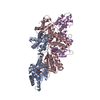 5uj7C 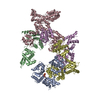 5ujmC  4xgcS C: citing same article ( S: Starting model for refinement |
|---|---|
| Similar structure data |
- Links
Links
- Assembly
Assembly
| Deposited unit | 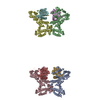
| ||||||||
|---|---|---|---|---|---|---|---|---|---|
| 1 | 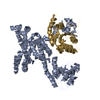
| ||||||||
| 2 | 
| ||||||||
| 3 | 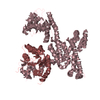
| ||||||||
| 4 | 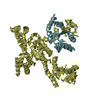
| ||||||||
| 5 | 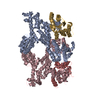
| ||||||||
| 6 | 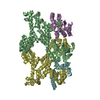
| ||||||||
| Unit cell |
|
- Components
Components
| #1: Protein | Mass: 82436.133 Da / Num. of mol.: 4 Source method: isolated from a genetically manipulated source Source: (gene. exp.)  Homo sapiens (human) / Gene: ORC3, LATHEO, ORC3L Homo sapiens (human) / Gene: ORC3, LATHEO, ORC3LProduction host:  Spodoptera aff. frugiperda 2 RZ-2014 (butterflies/moths) Spodoptera aff. frugiperda 2 RZ-2014 (butterflies/moths)References: UniProt: Q9UBD5 #2: Protein | Mass: 40309.777 Da / Num. of mol.: 4 Source method: isolated from a genetically manipulated source Source: (gene. exp.)  Homo sapiens (human) / Gene: ORC2, ORC2L Homo sapiens (human) / Gene: ORC2, ORC2LProduction host:  Spodoptera aff. frugiperda 2 RZ-2014 (butterflies/moths) Spodoptera aff. frugiperda 2 RZ-2014 (butterflies/moths)References: UniProt: Q13416 Has protein modification | Y | |
|---|
-Experimental details
-Experiment
| Experiment | Method:  X-RAY DIFFRACTION / Number of used crystals: 1 X-RAY DIFFRACTION / Number of used crystals: 1 |
|---|
- Sample preparation
Sample preparation
| Crystal | Density Matthews: 3.23 Å3/Da / Density % sol: 61.95 % |
|---|---|
| Crystal grow | Temperature: 290 K / Method: vapor diffusion, sitting drop Details: 9.5% PEG20000 50mM tri-Sodium-citrate 60mM Citric Acid 10mg/ml HO23 Ratio 1:1 |
-Data collection
| Diffraction | Mean temperature: 100 K |
|---|---|
| Diffraction source | Source:  SYNCHROTRON / Site: SYNCHROTRON / Site:  APS APS  / Beamline: 19-ID / Wavelength: 0.97926 Å / Beamline: 19-ID / Wavelength: 0.97926 Å |
| Detector | Type: DECTRIS PILATUS3 6M / Detector: PIXEL / Date: Feb 24, 2016 |
| Radiation | Protocol: SINGLE WAVELENGTH / Monochromatic (M) / Laue (L): M / Scattering type: x-ray |
| Radiation wavelength | Wavelength: 0.97926 Å / Relative weight: 1 |
| Reflection | Resolution: 6→20.07 Å / Num. obs: 15179 / % possible obs: 95 % / Redundancy: 3.4 % / CC1/2: 0.99 / Net I/σ(I): 5.7 |
| Reflection shell | Resolution: 6→6.21 Å / Redundancy: 3.6 % / Mean I/σ(I) obs: 1 / CC1/2: 0.422 / % possible all: 99.1 |
- Processing
Processing
| Software |
| ||||||||||||||||||||||||||||||||||||||||||
|---|---|---|---|---|---|---|---|---|---|---|---|---|---|---|---|---|---|---|---|---|---|---|---|---|---|---|---|---|---|---|---|---|---|---|---|---|---|---|---|---|---|---|---|
| Refinement | Method to determine structure:  MOLECULAR REPLACEMENT MOLECULAR REPLACEMENTStarting model: 4XGC - chains B,C Resolution: 6→20.067 Å / Cross valid method: FREE R-VALUE / σ(F): 1.34 / Phase error: 52.6 / Stereochemistry target values: TWIN_LSQ_F
| ||||||||||||||||||||||||||||||||||||||||||
| Solvent computation | Shrinkage radii: 0.9 Å / VDW probe radii: 1.11 Å / Solvent model: FLAT BULK SOLVENT MODEL | ||||||||||||||||||||||||||||||||||||||||||
| Refinement step | Cycle: LAST / Resolution: 6→20.067 Å
| ||||||||||||||||||||||||||||||||||||||||||
| Refine LS restraints |
| ||||||||||||||||||||||||||||||||||||||||||
| LS refinement shell |
|
 Movie
Movie Controller
Controller





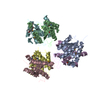
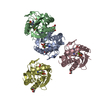

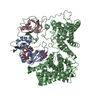

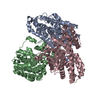
 PDBj
PDBj


